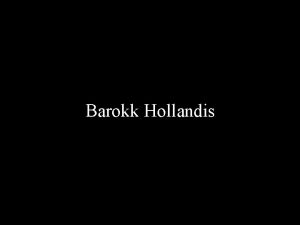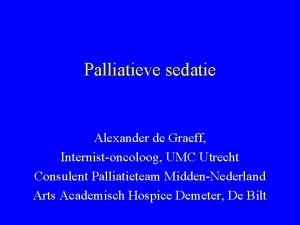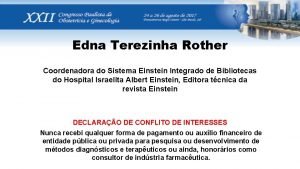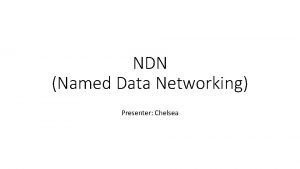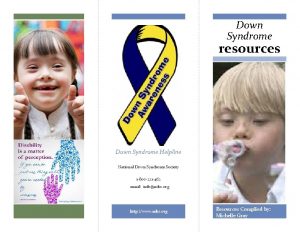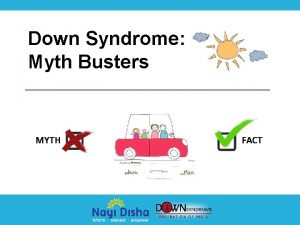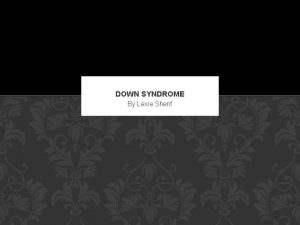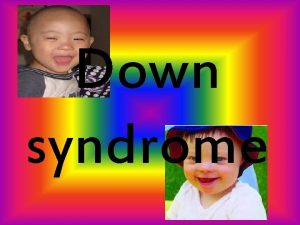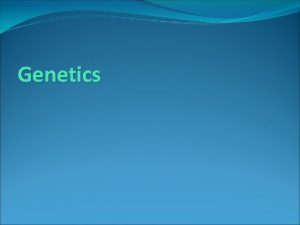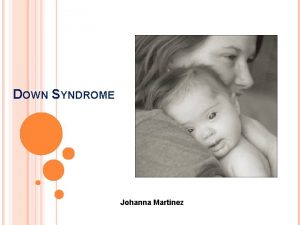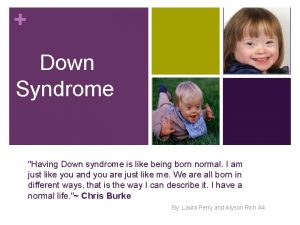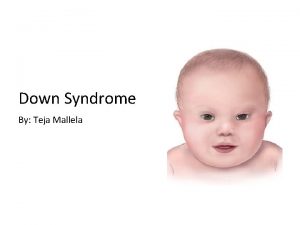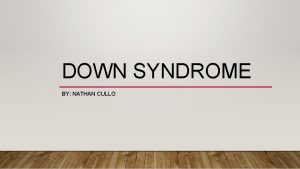Down Syndrome Chelsea Graeff Down Syndrome DS 40











- Slides: 11

Down Syndrome Chelsea Graeff

Down Syndrome (DS) • • 40% fetuses miscarry or are stillborn All cases show slowed mental development • Increased risk of depression, psychosis, disruptive behavior disorders, anxiety and autism. • Some cases show: • Loose joints, thyroid disorders, digestive issues, early onset Alzheimer's, leukemia, celiac disease, shortness, obesity, hearing or vision problems, infertility, immune deficiencies, epilepsy, small mouth, protruding poor muscleof tone by the tongue, triplication the Down syndrome is defined 21 st chromosome, and is the most common form of intellectual disability. This disability effects more than 400, 000 people in the United States and occurs in one in every 800 births.

Prenatal Diagnosis • Amniocentesis • Needle draws amniotic fluid to be analyze fetal cells • Carries risk of miscarriage • Chorionic villus sampling (CVS) • Cells called chorionic villi taken from the placenta attached to the uterus wall and analyzed • Carries risk of miscarriage • Triple Screen/ Quadruple screen • Tests mother’s blood for proteins and hormones associated with DS is second trimester • Nuchal Translucency Ultrasound • Tests fluid behind the fetus’ neck, increased amounts are associated with DS • Ultrasound/ 3 d Ultrasound • Non invasive blood tests • Detect placental messenger RNA in mothers blood • Measure bloodstream fragments of chromosome 21 70% expectant mothers who receive prenatal diagnosis of Down Syndrome choose to abort

In the 19 th century people with intellectual disabilities were thought to be unteachable and were commonly institutionalized. Eugenics contributed to this school of thought. Down Syndrome was no exception. However, other schools of thought began to develop around the idea that people with intellectual disabilities could learn, and with early intervention, could develop their cognitive abilities in a developmental trajectory of their own. Nature Vs. Nurture Debate

1848 - Samuel G Howe’s Report Made to the Massachusetts Legislature describes the cognitively disables as, “always a burden on the public” and “worse than useless 1927 - Oliver Wendell Holmes’ Supreme Court Decision make forced sterilization of people with disabilities, especially those with intellectual disabilities, law 1866 - John Langdon identifies Down Syndrome for the first time, referring to his subjects as “Mongoloids” or “Mongoloid Idiots” due to their slanted eyes resembling that of people of Mongolia 1968 - Ethicist Joseph Fletcher wrote about the action of putting a Down Syndrome baby “away” carrying no guilt for the parents in Atlantic Monthly 1961 Psychoanalysts Albert Solnit and Mary Stark lobby for measures to minimize the “trauma” inflicted upon DS mothers because of their misfortune in giving birth to a DS child

Edouard Seguin, director of the Hospice des Incurables in Paris was the first to recognize merits of early intervention for the intellectually disabled Nurture 1933 -1939 New Deal subsidizes teaching jobs 1906 - Maia Montessori opens Casa dei Bambini 1935 Social Security Act. Federal Government pledges to match state funds for treating the disabled 1946 - US Education Department sets up Section for Exceptional Children leading to better educational programs for children with disabilities 1958 - French Geneticist, Jerome Lejeune, presents evidence of Down Syndrome being linked to the triplication of the 21 st chromosome 1950 - Ann Greenburg, the mother of a child with DS fellow parents found the Association for Retarded Children, known now as Arc

1961 - As presidents, John F. Kennedy establishes a commission to study mental retardation and its possible prevention 1965 - Head Start is founded and their principles begin to be applied to people with cognitive disabilities, including DS 1962 President Kennedy’s sister Eunice Kennedy Shriver writes an article about her sister, Rosemary, who suffered from an intellectual disability Nurture Cont. 1990 Americans With Disabilities Act is passed strengthening Rehabilitation Act 1973 Congress passes The Rehabilitation Act, prohibiting discrimination against people with disabilities within federally funded programs 1990 Individuals with Disabilities Education Act is passed requiring all children with disabilities to receive free and appropriate education in least restrictive

Early Intervention Federal program for infants with many different ailments, including intellectual disabilities such as Down Syndrome. It provides services and training for families of any socioeconomic level. For infants with Down Syndrome there is a strong focus on sensory stimulation of all kinds. Early Intervention, Mainstreaming, Inclusion

Because cognitive ability differs widely in people diagnosed with Down Syndrome, there are many outcomes that can occur even with early intervention. Some children develop along the same lines as their peers until early elementary, some never reach the milestones of their peers. Some are able to hold a job as they grow into adulthood, others are not. Many live at home with their family or other care takers, others are placed in an assisted living home as they age into a time they should be on their own. Very few have the ability to live on their own. Cognitive Ability Differs Widely

“I really think, almost to a one, the siblings of kids with Down’s grow up to more sensitive and thoughtfulmaybe even more fulfilled- than the rest of the population. ” Parent Perspectives: From “Holland” “The primary job of most parents is to make their kids think they can do anything; my primary job is to take him down. Reduced to a sentence, its, ‘You’re not smart enough to do what you want to do. ’ Do you know how much I hate having to say that? ” “I would love for Lynn to be a teacher, or a doctor. And she’s a cafeteria worker. But for her, it’s perfect. She loves that paycheck, and she goes to the bank and cashes it and puts it in her checking account. Writes her own checks. That’s a big thing for her. So I’ve learned to love it too. ” “All of my friends had these children they thought were perfect, and they’ve had to come to terms with their children’s limitations and problems. I had this baby everyone thought was a disaster, and my journey has been to find all of things that are amazing “It was like I was trying to get FM on an AM radio in my old life. In a weird way, it was like it happened so I could see what I was capable of. Every single trait I had that I wasn’t good at, I’ve had to develop because of him. ”

References: Solomon, A. (2012). Far from the tree: Parents, children and the search for identity [e. Book edition]. Scribner.
